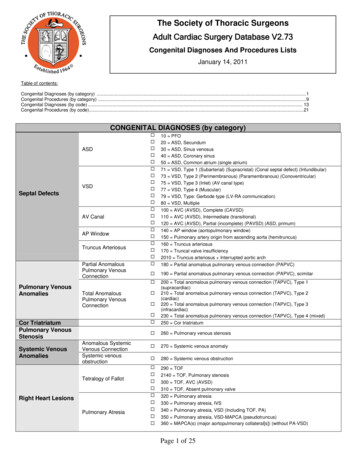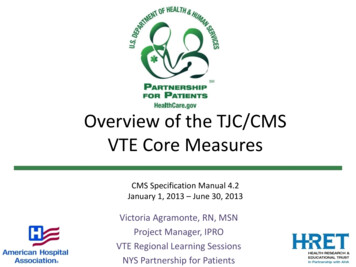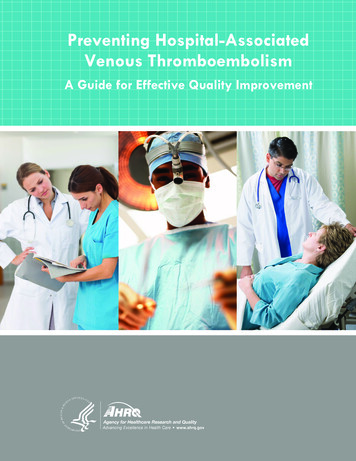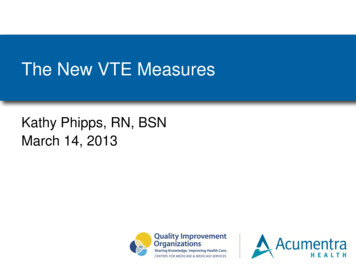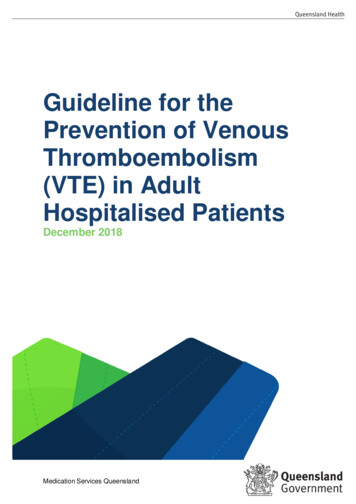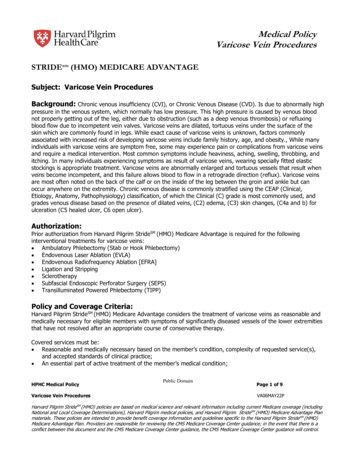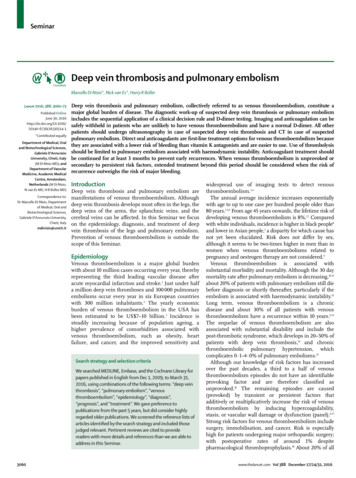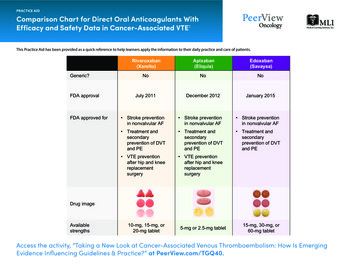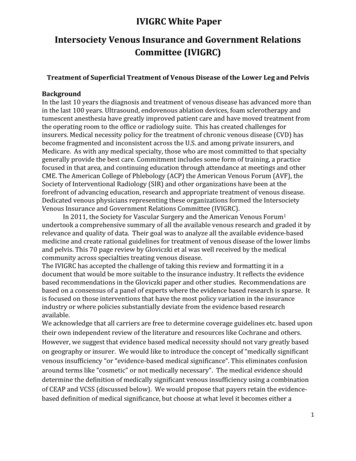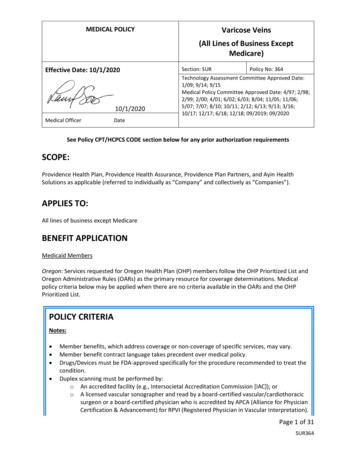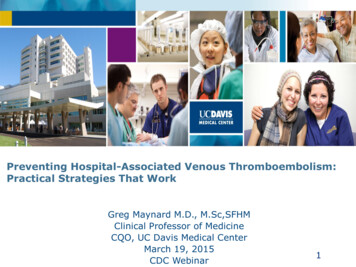
Transcription
Preventing Hospital-Associated Venous Thromboembolism:Practical Strategies That WorkGreg Maynard M.D., M.Sc,SFHMClinical Professor of MedicineCQO, UC Davis Medical CenterMarch 19, 2015CDC Webinar1
Conflict of InterestExecutive Committee Mariner VTE Prevention trial of extended duration prophylaxis inmedical patientsAHRQ DVT Prevention Guide author2
Abbreviations – Terms VTE – venous thromboembolismVTE-P VTE Prevention / prophylaxisHA VTE – hospital-associated VTECDS - Clinical decision supportIPCD – intermittent pneumatic compression devicesSCD – sequential compression devicesGCS – graduated compression stockingsExtended duration prophylaxis - beyond hospital stayLMWH - low-molecular weight heparinUFH - unfractionated heparinLDUH - low dose unfractionated heparinPAH - Pulmonary artery hypertensionAT8 - ACCP Anticoagulation / DVT Prevention guidelines (2008)AT9 - ACCP Anticoagulation / DVT Prevention guidelines (2102)3
VTEA Major Source of Mortality and Morbidity 350,000 to 650,000 with VTE per year 100,000 to 200,000 deaths per year About half are hospital related. VTE is primary cause of fatality in half– More than HIV, MVAs, Breast CA combined– Equals 1 jumbo jet crash / day 10% of hospital deaths– PE among top sources of preventable hospitalrelated death Huge costs and morbidity (recurrence, postthrombotic syndrome, chronic PAH, anticoag)Surgeon General’s Call to Action to Prevent DVT and PE 2008 DHHS4
SourcesQI Framework and Strategies that Work UC San Diego and Univ. of California VTEP CollaborativeSHM / AHRQ improvement guides and CollaborativeExperience, mentoring other hospitals via UCSD CIISJohns Hopkins experienceSystematic reviewsKahn SR, Morrison DR, Cohen JM, Emed J, Tagalakis V, Roussin A, Geerts W. Interventions for implementation ofthromboprophylaxis in hospitalized medical and surgical patients at risk for venous thromboembolism (Review). CochraneDatabase of Systematic Reviews 2013, Issue 7. Art. No.: CD008201. DOI: 10.1002/14651858.CD008201.pub2.Streiff MB, Carolan HT, Hobson DB, Kraus PS, Holzmueller CG, Demski R, et al. Lessons from the Johns Hopkins MultiDisciplinary Venous Thromboembolism (VTE) Prevention Collaborative. BMJ 2012; Jun 19;344:e3935.Kakkar AK, Davidson BL, Haas SK. Compliance with recommended prophylaxis for venous thromboembolism: improving the useand rate of uptake of clinical practice guidelines. J Thromb Haemost. 2004;2:221–227.Tooher R, Middleton P, Pham C, et al. A systematic review of strategies to improve prophylaxis for venous thromboembolism inhospitals. Ann Surg 2005; 241:397–415.Maynard G, Stein J. Designing and Implementing Effective VTE Prevention Protocols: Lessons from Collaboratives. J ThrombThrombolysis 2010 Feb:29(2):159-166.5
Strategies to Reduce HA VTE Centralized steering group for institution wide approachReview and distill the evidence / best practicesStandardize – Create a VTE Prevention ProtocolEmbed protocol guidance into order sets, hard stops for useon admission, transfer, and post op – Provide seamless CDSGo beyond core measures / SCIP - better measuresActive day-to-day surveillance, in addition to monthly /quarterlyMultiple mutually reinforcing interventions to reinforceprotocolActive vs passive interventionsAddress adherence / administration of prophylaxisAddress other failure modes / contributing factors to HA VTE6
77
ProtocolThe Essential First InterventionVTE Protocol1) a standardized VTE risk assessment, linked to 2) a menu of appropriate prophylaxis options, plus 3) a list of contraindications to pharmacologic VTEprophylaxisChallenges:Make it easy to use (“automatic”)Make sure it captures almost all patientsTrade-off between guidance and ease of use /efficiency8
ProtocolCharacteristics of the hypothetical ideal protocolTrade-offs and prioritization of characteristics often needed Accurately detects all patients at risk for DVT. Reliably excludes patients who would be unlikely todevelop DVT, minimizing inappropriate overprophylaxis in those of lower risk. Provides actionable recommendations for permutationsof VTE and bleeding risk. Simple to use in routine clinical practice Identifies patients that should have a combination ofmechanical and anticoagulant prophylaxis. Lends itself to automation or dynamic ongoing reevaluations. Integration results in convincing decreases in hospitalassociated VTE without any increase in bleeding.9
Hierarchy of ReliabilityLevelPredictedProphylaxisrate1No protocol* (“State of Nature”)40%2Decision support exists but not linked to orderwriting, or prompts within orders but nodecision supportProtocol well-integrated(into orders at point-of-care)Protocol enhanced(by other QI / high reliability strategies)Oversights identified and addressed inreal time50%3451065-85%90%95 %
Protocol Local Standards of best practiceWritten outAlgorithmic decision trees can be usefulInclude operational definitions*Must have enough detail to be measurable and makejudgments re:Is this case meeting our standard of care? Examples requiring operational definitions*– High INR– Low platelet counts– Impaired mobility– “Low Risk”11
Prompt - Not a protocol - No CDS offeredDVT PROPHYLAXIS ORDERS Anti thromboembolism Stockings Sequential Compression Devices UFH 5000 units SubQ q 12 hours UFH 5000 units SubQ q 8 hours LMWH (Enoxaparin) 40 mg SubQ q day LMWH (Enoxaparin) 30 mg SubQ q 12 hours No Prophylaxis, Ambulate12
Over 20 different VTE risk assessment models No consensus on what is best in clinical practice Individualized point-based scoring (quantitative) models–Generally more rigorously validated in determining risk, but not in clinical practiceExamples:–Caprini–Padua–IMPROVE Grouping or “bucket” models–Generally not as well validated in predicting risk, but easier to implement, morepublished / unpublished success stories in reducing HA VTEExamples:–NICE / NHS guidelines, Australia / New Zealand working group model–Classic “3 bucket” model–Updated “3 bucket” grouping model13
Caprini Model Validated inpredicting risk Can be difficultto use reliably Only 1publishedsuccess inclinical practicepublished after30 years of use. Works best incenters withadvanced CDSto make iteasier / moreautomated14
Risk Assessment- Classic “3 bucket” model derived from AT8Low Risk: Minor surgery in mobile patients. Medicalpatients who are fully mobile. Observation patients withexpected hospital stay 48 hours.No prophylaxis, reassessperiodically, ambulate.Moderate Risk: Most general, thoracic, open gynecologic orurologic surgery patients. Medical patients, impairedmobility from baseline or acutely ill.UFH or LMWH prophylaxis*High Risk: Hip or knee arthroplasty, hip fracturesurgery. multiple major trauma, spinal cord injury or majorspinal surgery, Abdominal-pelvic surgery for cancer.IPCD AND LMWH or otheranticoagulant**For those at moderate or high risk and contraindications to anticoagulation, use IPCD.15
Percent of Randomly Sampled Inpatients withAdequate VTE ProphylaxisJ Hosp Med 2010 Jan:5(1):10-18.N 2,944mean 82 audits / month100%90%80%Real time ID &interventionOrder Set Implementation& 2QQ1'0'05520%1616
UCSD resultsHospital Acquired VTE by Year2005200620072008Patients at Risk9,7209,92311,207Cases w/ any VTERisk for HA VTEOdds Ratio(95% CI)1311 in 761.01381 in 731.03(0.81, 1.32)921 in 1220.61#(0.46, 0.80)Cases with PERisk for PEOdds Ratio(95% CI)211 in 4631.0221 in 4511.02(0.54, 1.96)151 in 7470.62(0.30, 1.26)12Cases with DVT (and no PE)Risk for DVTOdds Ratio(95% CI)1101 in 881.01161 in 851.03(0.79, 1.96)771 in 1460.61*(0.45, 0.82)68Cases w/ Preventable VTERisk for Preventable VTEOdds Ratio(95% CI)441 in 2211.0211 in 4730.47#(0.26, 0.80)71 in 1,6010.14*(0.05, 0.31)6# p 0.01 *p 0.001J Hosp Med 2010 Jan:5(1):10-18.8017
Updated Model – More c/w AT9 guidelines18
Courtesy Dr. Richard WhiteUC Davis Medical Center3 bucket model algorithm assoc. w/ reduction in HA VTE19
Effective Implementation / CDS Principles1.2.3.Keep it simple for the end usera.Some adjustments can be done behind the scenes (pharmacy adjustment of dose or perioptiming, for example)b.Minimize calculations / clicks, automate process for themc.Streamline options, offer only preferred choicesDon’t interrupt the work flowa.Integrate risk assessment in admit / transfer / post op processb.Keep VTE risk assessment, bleeding risk assessment, and ordering of risk-appropriateprophylaxis together as a unified process.Design reliability into the processa.Forcing functions / hard stop for VTEPb.Present preferred risk appropriate prophylaxis as the default option once risk levelchosenc.Scheduling and redundant checks for highest risk patientsd.Standardization for services / groups of patients (discourage over-customization at providerlevel)20
Effective Implementation / CDS Principles4. Pilot interventions on a small scalea.Engage medical staff groups, look for barriers and special needsb.Use case histories or real patient scenarios to simulate use of theorder set5. Monitor use of the protocol. Build measurement and monitoringinto order set and documentation toolsa.Capture VTE risk, declaration of contraindications, what is orderedb.Ambulation, IPCD adherencec.Audits – order sets being used? Completed properly?d.Learn for variation from protocol21
Key StrategiesImplementing Caprini ModelCourtesy Marc Moote, PA-C Scope: ALL adult inpatientsStandardized VTE Protocol – Caprini modelMandatory risk assessment with CPOE hard-stopClinical decision support to drive clinical practiceRequired documentation of contraindicationsData feedback to services regarding performanceVTE prophylaxis included as peer review (OPPE)indicator for many services Review of EVERY VTE event that occurs in thehealth system for preventability22
Reorganization / grouping of CapriniVTE risk factors make it more userfriendlyPoint total calculated for user,prophylaxis recommendation basedon risk score23
VTE Risk Level, contraindications (if present) and orderedprophylaxis capture for icated24
Classic 3 bucket model implementationCourtesy Dr. Lori Porter, Good Samaritan Regional Medical Center25
Risk-appropriate prophylaxis options appear after risklevel chosen. High Risk requires dual prophylaxis26
Contraindications captured if pharmacologicprophylaxis not ordered for a patient at risk of DVT.27
Any Attempt to uncheck theorder will give this messageJohns Hopkins Medicine DVT Prevention Order Set ExampleCourtesy Dr. Michael Streiff Embedded in Medicine Admission Orders Hard Stop to use (vs delete entire order set)28
Patient age, weight, renalfunction and relevant labsimported from database29
Mandatory Selections Risk Factors Contraindications30
ProphylaxisRecommendation31
Documentationof RiskAssessment32
MeasuresTJC and SCIP Measures Relatively low bar Do not drive rapid cycle QI Looks only at set points in hospitalization– Does not address patients who “fall off” protocol TJC measures: any prophylaxis adequateprophylaxisGo Beyond Core Measures to achieve better results Judge adequacy of prophylaxis by adherence to yourprotocol HA VTE readmitted cases with new VTE those notpresent on admission Monitor for lapses in care on a day-to-day basis33
MeasuresOutcomes measure for HA VTE and Preventable VTE Real time capture using imaging system, andconcurrent review of cases to see if they are HA orcommunity acquired, preventable / not preventable.Not practical for most, but may be gold standard. Improved methodology using administrative data– Captures readmitted patients as well as those with POA No– Captures UE DVT, but tracks them separately– Higher bar for ‘preventable’– Audits to validate coding Administrative coding Caveats34
Key to successNeed to address all common failures in process No protocol / standardized order setsOrder sets / prompts for VTE P in place, but no guidanceOrder sets with guidance in place but bypassedOrder sets with guidance in place and used, but usedincorrectlyPatient gets placed on right prophylaxis, but VTE / bleeding riskchanges and adjustment not made.Prophylaxis gets missed / changed on transfer / peri-op settingCorrect prophylaxis ordered, but not administered, or patientrefuses.Patient not mobilized optimallyPreventable risk factors (central line) not optimally managedPatient had indication for extended duration prophylaxis, butdid not get it35
Strategies for VTE PreventionBeyond order sets Good protocol driven order set is well integrated Assessing administration / adherence– (not just orders) Alert Systems– Electronic alerts (E-alerts)– Human alerts Raising situational awareness (eg checklists)Audit and feedbackMeasure-ventionIncrease activityOptimize central linesFocus on extended duration for select populations36
37
MEASURE-VENTIONDaily measurement drives concurrent intervention(i.e., same as Level 5 in Hierarchy)Identify suboptimal prophylaxis in real time– Ongoing assessment– Use for real-time intervention38
28 Patients – Measure-vention20 on anticoagulation4 on mechanical prophylaxis with lab contraindication3 on Nothing1 mechanical39
Effect of Situational Awareness onPrevalence of VTE Prophylaxis byNursing UnitPrevalence of VTE Prophylaxis100%90%80%Hospital A, 1st Nursing UnitBaselinePost-InterventionUCL:93% 104%Mean:73%99% (p 1611162126313641465156616671768186Hospital DaysHospital A, 2nd Nursing % (p 0.01)LCL:46% 72%Prevalence of VTE %10%0%16111621263136414651566166717681869196 101Prevalence of VTE Prophylaxis100%90%80%Hospital B, 1st Nursing UnitBaselinePost-InterventionUCL:89% 108%Mean:71%98% (p 0.01)LCL:53% 88%70%60%50%UCL Upper Control LimitLCL Lower Control 1869196 1014040
Patient Enemy #1: BedComplications Associated with Hospital Beds:– Aspiration pneumonia– Deep Vein Thrombosis– Delirium– Pulmonary Emboli– Pressure Ulcers– Ileus, Bowel Paralysis41
PICC Lines Increasing use Symptomatic VTE associated with PICC duringhospitalization3.0 -7.8% Significant CLABSI burden Occlusion complications / lytics42
Practices to Reduce PICC complications Minimize exposure to PICCs– Maximize midline / PIV– Remove asapSize matters – smaller PICCs fewer DVTSmallest number of lumensProper flushingFollowing all infection control practicesFewer attempts to place PICCAppropriately sized catheter in proper positionAppropriate DVT prophylaxis probably helps some, butnot as much as for leg DVT Special catheters? Evans RS, Sharp JH, Linford LH, Lloyd JF et al. Reduction of PeripherallyInserted Central Catheter-Associated DVT. Chest 2013; 143(3):626-633.Mai C, Hunt D. Upper-extremity Deep Vein Thrombosis: A Review. Am J Med2011; 124:402-407.43
Questions / Answers / Comments? Coming Spring 2015 - Major Revision / UpdateAHRQ DVT Prevention Guide Questions on this webinar series? ContactCynthia Sayers at 404-498-0020.44
develop DVT, minimizing inappropriate over-prophylaxis in those of lower risk. Provides actionable recommendations for permutations of VTE and bleeding risk. Simple to use in routine clinical practice Identifies patients that should have a combination of mechanical and anticoagulant prophylaxis.
